The Wrens of Dirk Hartog Island
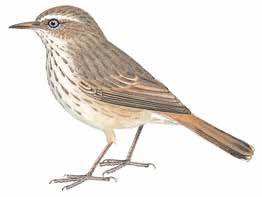
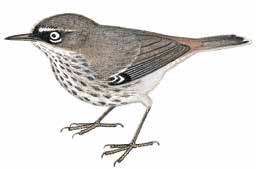
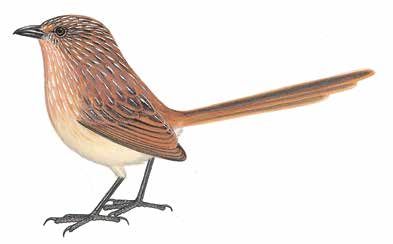
Dirk Hartog rufous fieldwren
Calamanthus campestris hartogi
White-browed scrubwren
Sericornis frontalis balstoni
Thick-billed grasswren
Amytornis textilis
WA status: Vulnerable
Size: 11–14cm in length (including tail).
Male: upperparts greyish olive coarsely streaked with
blackish brown. A white stripe extends over the eye. The
tail is reddish brown tipped white. Underparts mostly
white streaked with blackish brown.
Female: differs from male in being slightly duller, with
the streaks paler and narrower.
Voice: a loud spirited song usually uttered from the top
of a bush.
Breeding: June to August.
Nest: dome shaped with a circular side entrance.
This species is the most commonly encountered wren on
the island. Found in most habitats including heaths, low
scrubs and samphire flats.
WA status: Secure
Size: 11–13cm in length (including tail).
Male: greyish brown with black lores (feathers between
bill and eye), and a white line above the eye.
Female: similar to male but with brown lores.
Voice: distinctive call, a high pitched ‘tseer-tseer-tseer’
and ‘seet-you, seet-you’.
Breeding: June to August.
Nest: untidy dome of grass, bark, leaves and flower heads
lined with feathers and with a circular side entrance.
Common on the island usually in pairs and small
parties in dense shrubland. Inquisitive and commonly
approaches birdwatchers.
WA status: In need of monitoring
Size: 17–19cm in length (including tail).
Male: dull reddish brown, finely streaked with white on
the head, back and breast.
Female: similar to males but has chestnut flanks.
Voice: a series of high-pitched whistles and trills.
Breeding: from late June to early September.
Nest: cup or part dome with hood reduced or absent.
This species was formerly found on Dirk Hartog Island,
but is now believed to be locally extinct. Surveys are
continuing. It is still locally common on the Peron
Peninsula
 |
 |
 |
 |
 |
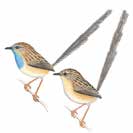 |
 |

Ilustrations and text courtesy of Western Australian Museum, Front cover photo: thick-billed grasswren. Photo – Babs and Bert Wells/DPaW, Information current at May 2014
The wrens of
Dirk Hartog Island
National Park
Identification guide
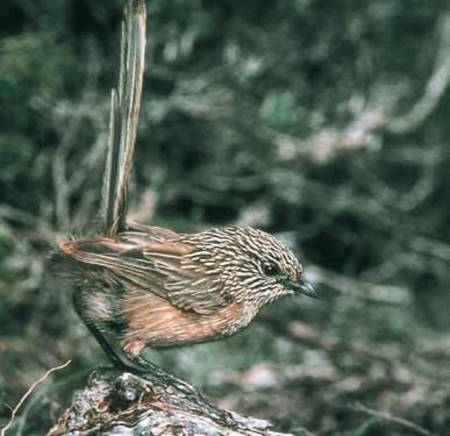

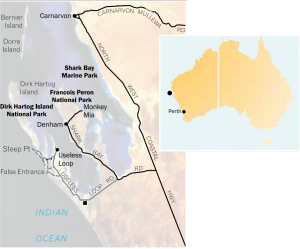
The wrens of Dirk Hartog Island comprise six species: two fairy-wrens, an emu-wren, a grasswren, scrubwren and a fieldwren.
They are a group of small, thin-billed, mainly insectivorous birds that live on or near the ground in shrubs, heaths and thickets.
They are called ‘wrens’ because their cocked or upright tails give them the appearance or resemblance to the true wrens of the Americas, Europe and northern Asia.
The conservation of these birds is ongoing. This guide should help avian enthusiasts and conservationists alike understand the fragile nature of these species on Dirk Hartog Island and how the identification of these birds will help save them for future generations to enjoy.
Contacts
If you have seen a thick-billed grasswren on
Dirk Hartog Island, please contact the Department of
Parks and Wildlife office in Denham and provide details
of the location, date and any photos taken.
Phone: (08) 9948 2226
Address: Knight Terrace, Denham WA 6537
Email: info@dpaw.wa.gov.au

Female

Female
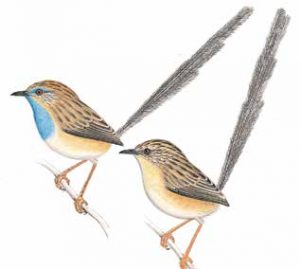
Female
Black and white fairy-wren
Malurus leucopterus leucopterus
Variegated fairy-wren
Malurus lamberti
Southern emu-wren
Stipiturus malachurus hartogi
WA status: Vulnerable
Size: 11–13cm in length (including tail).
Breeding male: mostly glossy black, except for the
wings, which are largely white, dull blue tail.
Non-breeding male: similar to female except for a
blackish bill and slightly brighter dull blue tail.
Adult female: mostly greyish brown with a greyishwhite
eye ring and light brown bill.
Juvenile: like female.
Breeding: July to August.
Voice: Prolonged, undulating reel, like a sewing machine.
Nest: small compact dome with a side entrance made of
wind-blown seagrass, insect cocoons and flower heads,
bound together with spider web and built near the
ground in dense bushes.
This subspecies is endemic to the island and is common
in heaths and chenopod (saltbush) flats and spinifex
throughout the island. It is closely related to the blue
plumaged, white-winged fairy-wren Malurus leucopterus
leuconotus found on the mainland.
WA status: Secure
Size: 12–14cm in length (including tail).
Breeding male: head and back bright blue; shoulders
chestnut; wings brown; tail dull blue.
Non-breeding male: tail dull blue and rest of upperparts
are brown and the underparts are white.
Female: differs from non-breeding male in having a
brown instead of a black bill and a reddish brown eyering.
Juvenile: like female but duller.
Breeding: late July to early September.
Nest: small coarsely made dome with a side entrance
near the top.
Voice: territorial song is a high-pitched whirring, reel and
a sharp ‘tseep’ contact call.
This species is common, occurring throughout the island
favouring all kinds of shrubland and heath including
melaleuca, acacia (wattles) and saltbush flats. Often
encountered in small groups.
WA status: Vulnerable
Size: 16–18cm in length (including tail).
Male: tiny greyish brown bird, with a pale blue breast
and stripe over eye and a very long filamentous tail that
resembles emu feathers.
Female: similar to male but lacks blue colouring.
Voice: territorial call is a high-pitched descending trill.
Breeding: July to August
Nest: small dome placed low down in a bush in dense
heath.
Moderately common on the island though very difficult
to detect. Usually in pairs or small parties and favouring
low shrubs and spinifex heaths.
